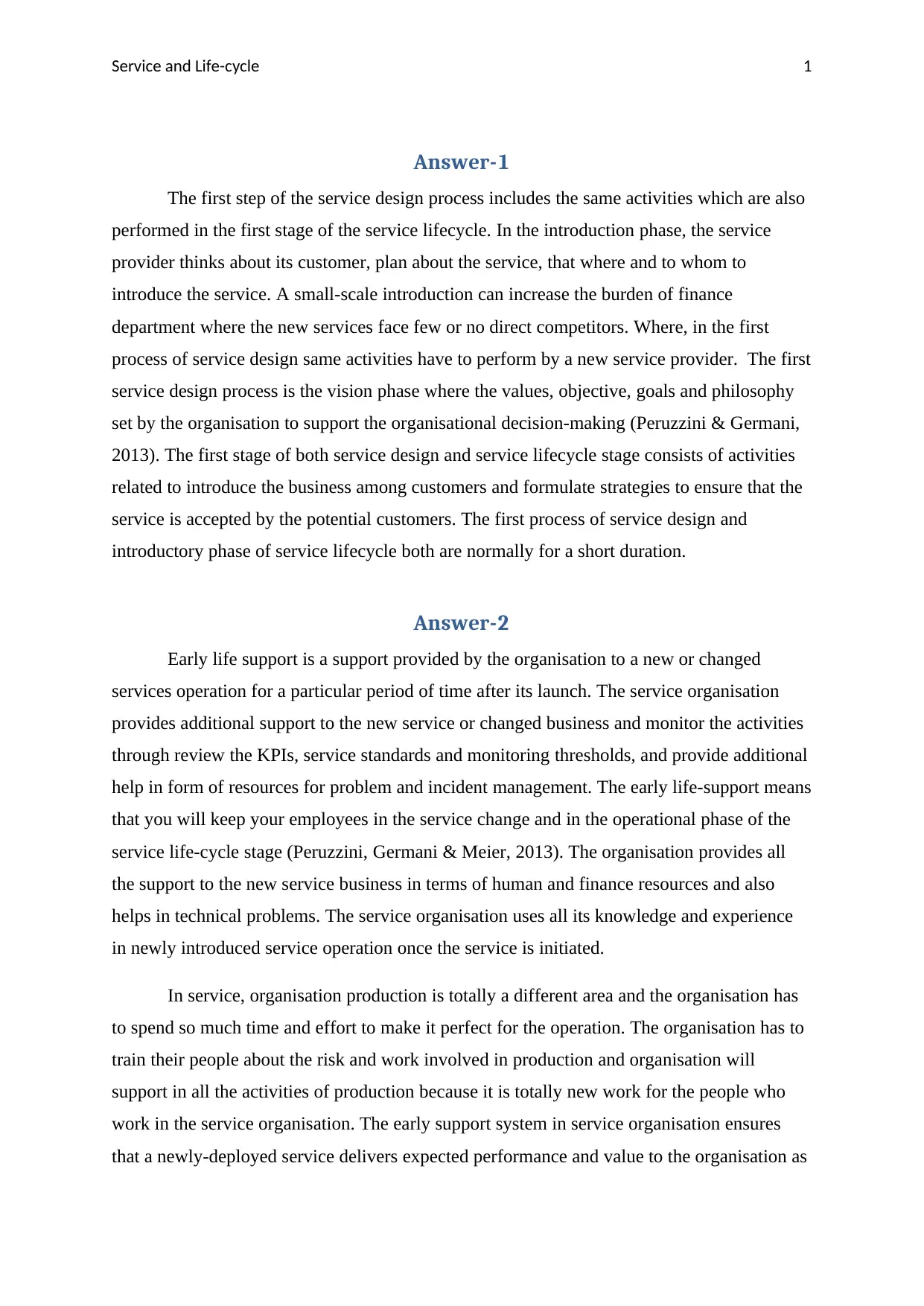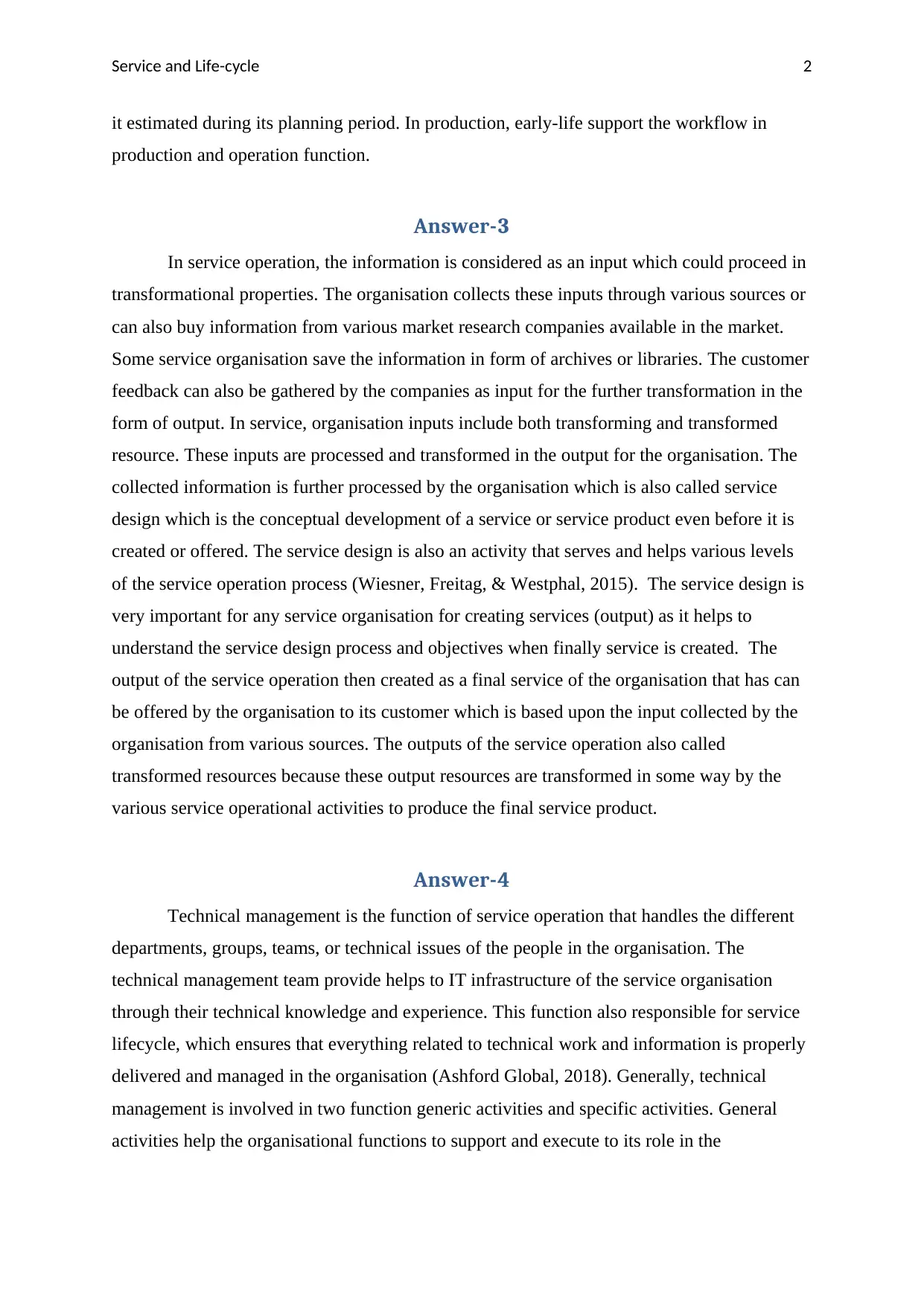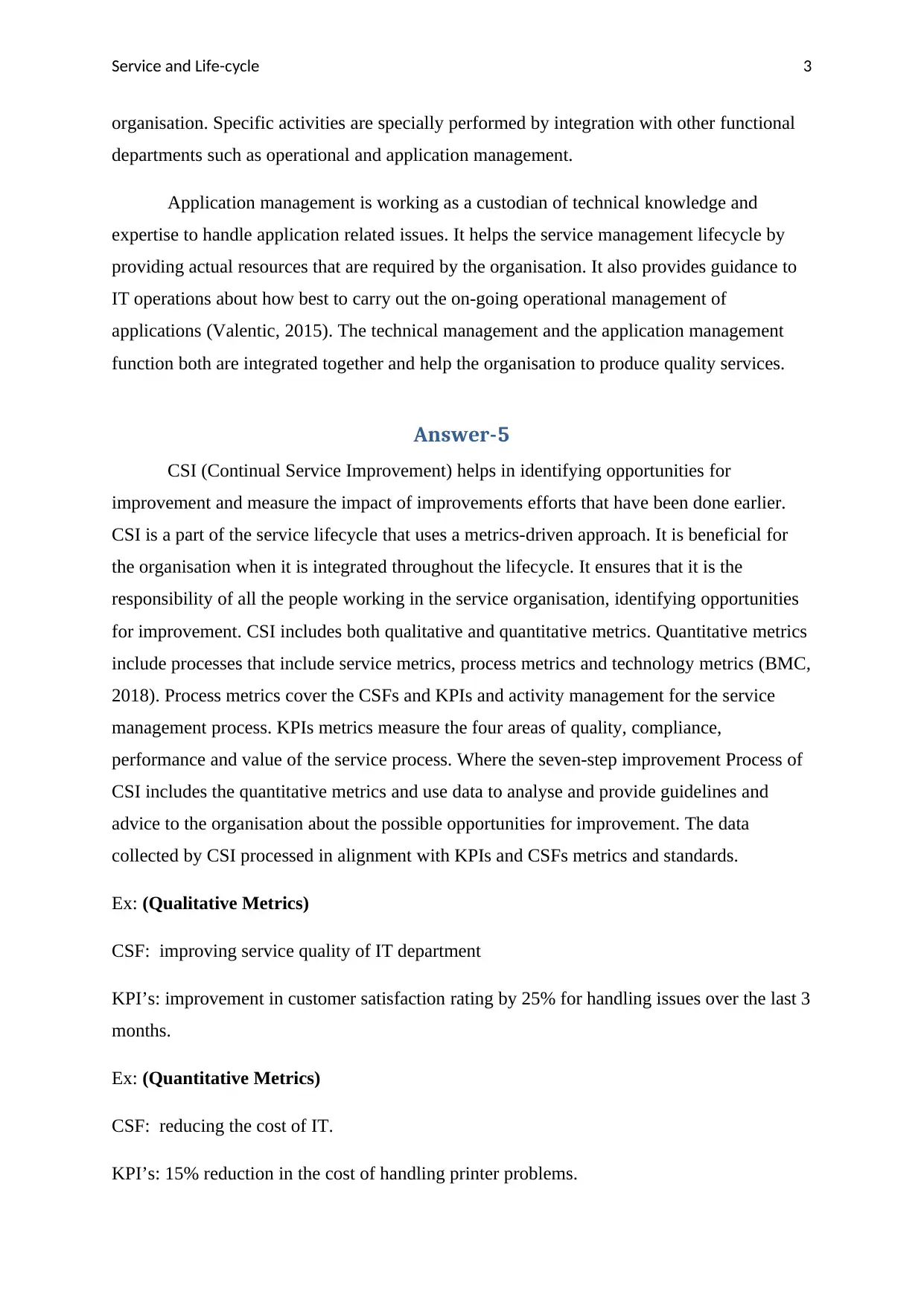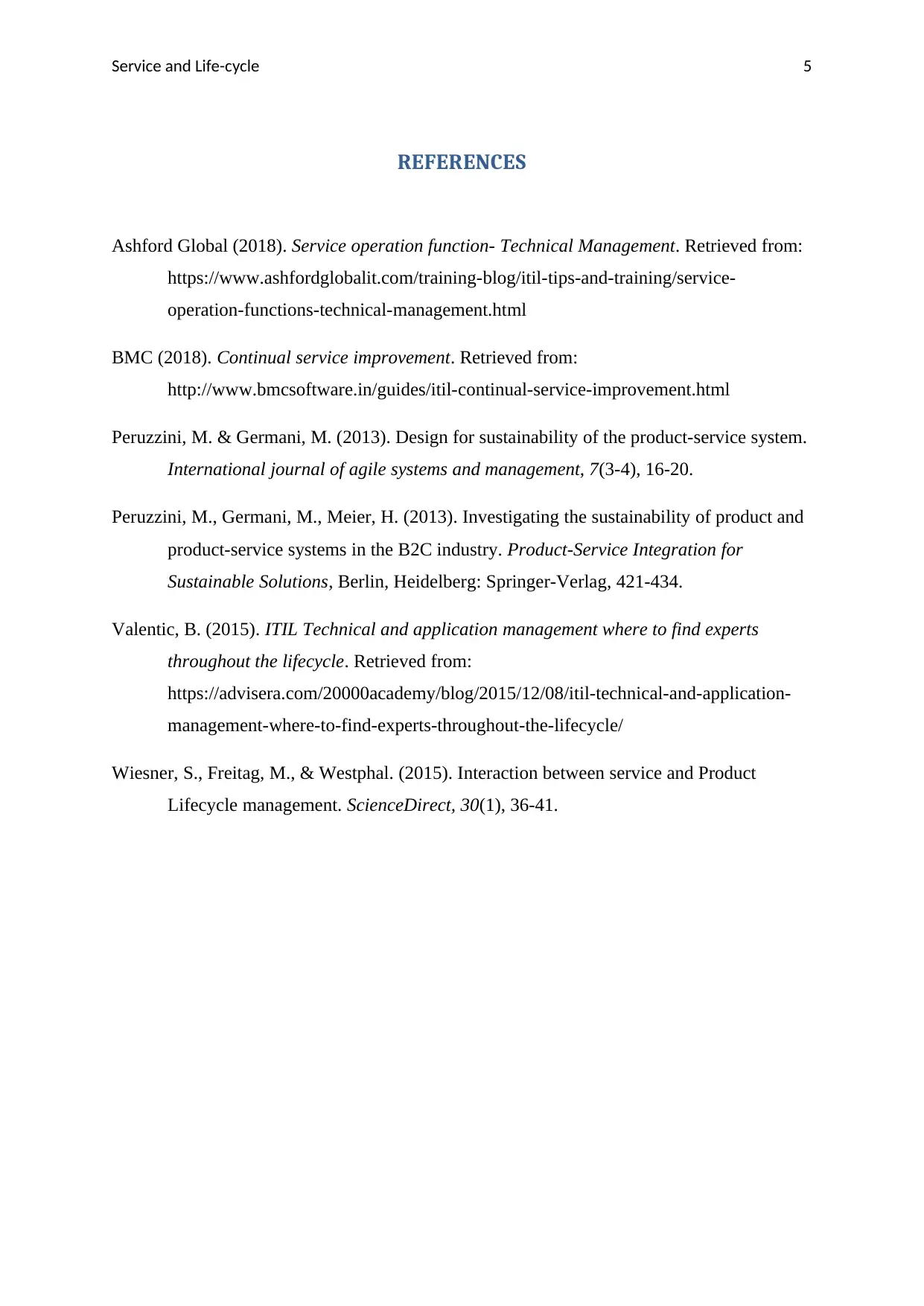Service and Life-cycle: Business Development Report and its Analysis
VerifiedAdded on 2023/06/10
|6
|1380
|149
Report
AI Summary
This report provides a detailed analysis of the service lifecycle and its relationship to business development. It begins by identifying the overlap between service design processes and other lifecycle stages, followed by an explanation of early life support and its significance in transitioning new services to production. The report then examines the inputs and outputs of service operation, highlighting the role of information and service design. Furthermore, it describes the functions of technical and application management within the service lifecycle. Finally, the report explores Continual Service Improvement (CSI) metrics, providing examples of both qualitative and quantitative measures. This report covers key concepts and offers valuable insights into service management and business development practices.

Running Head: Service and Life-cycle
Service and Life-cycle
Essay
System04104
7/6/2018
Service and Life-cycle
Essay
System04104
7/6/2018
Paraphrase This Document
Need a fresh take? Get an instant paraphrase of this document with our AI Paraphraser

Service and Life-cycle 1
Answer-1
The first step of the service design process includes the same activities which are also
performed in the first stage of the service lifecycle. In the introduction phase, the service
provider thinks about its customer, plan about the service, that where and to whom to
introduce the service. A small-scale introduction can increase the burden of finance
department where the new services face few or no direct competitors. Where, in the first
process of service design same activities have to perform by a new service provider. The first
service design process is the vision phase where the values, objective, goals and philosophy
set by the organisation to support the organisational decision-making (Peruzzini & Germani,
2013). The first stage of both service design and service lifecycle stage consists of activities
related to introduce the business among customers and formulate strategies to ensure that the
service is accepted by the potential customers. The first process of service design and
introductory phase of service lifecycle both are normally for a short duration.
Answer-2
Early life support is a support provided by the organisation to a new or changed
services operation for a particular period of time after its launch. The service organisation
provides additional support to the new service or changed business and monitor the activities
through review the KPIs, service standards and monitoring thresholds, and provide additional
help in form of resources for problem and incident management. The early life-support means
that you will keep your employees in the service change and in the operational phase of the
service life-cycle stage (Peruzzini, Germani & Meier, 2013). The organisation provides all
the support to the new service business in terms of human and finance resources and also
helps in technical problems. The service organisation uses all its knowledge and experience
in newly introduced service operation once the service is initiated.
In service, organisation production is totally a different area and the organisation has
to spend so much time and effort to make it perfect for the operation. The organisation has to
train their people about the risk and work involved in production and organisation will
support in all the activities of production because it is totally new work for the people who
work in the service organisation. The early support system in service organisation ensures
that a newly-deployed service delivers expected performance and value to the organisation as
Answer-1
The first step of the service design process includes the same activities which are also
performed in the first stage of the service lifecycle. In the introduction phase, the service
provider thinks about its customer, plan about the service, that where and to whom to
introduce the service. A small-scale introduction can increase the burden of finance
department where the new services face few or no direct competitors. Where, in the first
process of service design same activities have to perform by a new service provider. The first
service design process is the vision phase where the values, objective, goals and philosophy
set by the organisation to support the organisational decision-making (Peruzzini & Germani,
2013). The first stage of both service design and service lifecycle stage consists of activities
related to introduce the business among customers and formulate strategies to ensure that the
service is accepted by the potential customers. The first process of service design and
introductory phase of service lifecycle both are normally for a short duration.
Answer-2
Early life support is a support provided by the organisation to a new or changed
services operation for a particular period of time after its launch. The service organisation
provides additional support to the new service or changed business and monitor the activities
through review the KPIs, service standards and monitoring thresholds, and provide additional
help in form of resources for problem and incident management. The early life-support means
that you will keep your employees in the service change and in the operational phase of the
service life-cycle stage (Peruzzini, Germani & Meier, 2013). The organisation provides all
the support to the new service business in terms of human and finance resources and also
helps in technical problems. The service organisation uses all its knowledge and experience
in newly introduced service operation once the service is initiated.
In service, organisation production is totally a different area and the organisation has
to spend so much time and effort to make it perfect for the operation. The organisation has to
train their people about the risk and work involved in production and organisation will
support in all the activities of production because it is totally new work for the people who
work in the service organisation. The early support system in service organisation ensures
that a newly-deployed service delivers expected performance and value to the organisation as

Service and Life-cycle 2
it estimated during its planning period. In production, early-life support the workflow in
production and operation function.
Answer-3
In service operation, the information is considered as an input which could proceed in
transformational properties. The organisation collects these inputs through various sources or
can also buy information from various market research companies available in the market.
Some service organisation save the information in form of archives or libraries. The customer
feedback can also be gathered by the companies as input for the further transformation in the
form of output. In service, organisation inputs include both transforming and transformed
resource. These inputs are processed and transformed in the output for the organisation. The
collected information is further processed by the organisation which is also called service
design which is the conceptual development of a service or service product even before it is
created or offered. The service design is also an activity that serves and helps various levels
of the service operation process (Wiesner, Freitag, & Westphal, 2015). The service design is
very important for any service organisation for creating services (output) as it helps to
understand the service design process and objectives when finally service is created. The
output of the service operation then created as a final service of the organisation that has can
be offered by the organisation to its customer which is based upon the input collected by the
organisation from various sources. The outputs of the service operation also called
transformed resources because these output resources are transformed in some way by the
various service operational activities to produce the final service product.
Answer-4
Technical management is the function of service operation that handles the different
departments, groups, teams, or technical issues of the people in the organisation. The
technical management team provide helps to IT infrastructure of the service organisation
through their technical knowledge and experience. This function also responsible for service
lifecycle, which ensures that everything related to technical work and information is properly
delivered and managed in the organisation (Ashford Global, 2018). Generally, technical
management is involved in two function generic activities and specific activities. General
activities help the organisational functions to support and execute to its role in the
it estimated during its planning period. In production, early-life support the workflow in
production and operation function.
Answer-3
In service operation, the information is considered as an input which could proceed in
transformational properties. The organisation collects these inputs through various sources or
can also buy information from various market research companies available in the market.
Some service organisation save the information in form of archives or libraries. The customer
feedback can also be gathered by the companies as input for the further transformation in the
form of output. In service, organisation inputs include both transforming and transformed
resource. These inputs are processed and transformed in the output for the organisation. The
collected information is further processed by the organisation which is also called service
design which is the conceptual development of a service or service product even before it is
created or offered. The service design is also an activity that serves and helps various levels
of the service operation process (Wiesner, Freitag, & Westphal, 2015). The service design is
very important for any service organisation for creating services (output) as it helps to
understand the service design process and objectives when finally service is created. The
output of the service operation then created as a final service of the organisation that has can
be offered by the organisation to its customer which is based upon the input collected by the
organisation from various sources. The outputs of the service operation also called
transformed resources because these output resources are transformed in some way by the
various service operational activities to produce the final service product.
Answer-4
Technical management is the function of service operation that handles the different
departments, groups, teams, or technical issues of the people in the organisation. The
technical management team provide helps to IT infrastructure of the service organisation
through their technical knowledge and experience. This function also responsible for service
lifecycle, which ensures that everything related to technical work and information is properly
delivered and managed in the organisation (Ashford Global, 2018). Generally, technical
management is involved in two function generic activities and specific activities. General
activities help the organisational functions to support and execute to its role in the
⊘ This is a preview!⊘
Do you want full access?
Subscribe today to unlock all pages.

Trusted by 1+ million students worldwide

Service and Life-cycle 3
organisation. Specific activities are specially performed by integration with other functional
departments such as operational and application management.
Application management is working as a custodian of technical knowledge and
expertise to handle application related issues. It helps the service management lifecycle by
providing actual resources that are required by the organisation. It also provides guidance to
IT operations about how best to carry out the on-going operational management of
applications (Valentic, 2015). The technical management and the application management
function both are integrated together and help the organisation to produce quality services.
Answer-5
CSI (Continual Service Improvement) helps in identifying opportunities for
improvement and measure the impact of improvements efforts that have been done earlier.
CSI is a part of the service lifecycle that uses a metrics-driven approach. It is beneficial for
the organisation when it is integrated throughout the lifecycle. It ensures that it is the
responsibility of all the people working in the service organisation, identifying opportunities
for improvement. CSI includes both qualitative and quantitative metrics. Quantitative metrics
include processes that include service metrics, process metrics and technology metrics (BMC,
2018). Process metrics cover the CSFs and KPIs and activity management for the service
management process. KPIs metrics measure the four areas of quality, compliance,
performance and value of the service process. Where the seven-step improvement Process of
CSI includes the quantitative metrics and use data to analyse and provide guidelines and
advice to the organisation about the possible opportunities for improvement. The data
collected by CSI processed in alignment with KPIs and CSFs metrics and standards.
Ex: (Qualitative Metrics)
CSF: improving service quality of IT department
KPI’s: improvement in customer satisfaction rating by 25% for handling issues over the last 3
months.
Ex: (Quantitative Metrics)
CSF: reducing the cost of IT.
KPI’s: 15% reduction in the cost of handling printer problems.
organisation. Specific activities are specially performed by integration with other functional
departments such as operational and application management.
Application management is working as a custodian of technical knowledge and
expertise to handle application related issues. It helps the service management lifecycle by
providing actual resources that are required by the organisation. It also provides guidance to
IT operations about how best to carry out the on-going operational management of
applications (Valentic, 2015). The technical management and the application management
function both are integrated together and help the organisation to produce quality services.
Answer-5
CSI (Continual Service Improvement) helps in identifying opportunities for
improvement and measure the impact of improvements efforts that have been done earlier.
CSI is a part of the service lifecycle that uses a metrics-driven approach. It is beneficial for
the organisation when it is integrated throughout the lifecycle. It ensures that it is the
responsibility of all the people working in the service organisation, identifying opportunities
for improvement. CSI includes both qualitative and quantitative metrics. Quantitative metrics
include processes that include service metrics, process metrics and technology metrics (BMC,
2018). Process metrics cover the CSFs and KPIs and activity management for the service
management process. KPIs metrics measure the four areas of quality, compliance,
performance and value of the service process. Where the seven-step improvement Process of
CSI includes the quantitative metrics and use data to analyse and provide guidelines and
advice to the organisation about the possible opportunities for improvement. The data
collected by CSI processed in alignment with KPIs and CSFs metrics and standards.
Ex: (Qualitative Metrics)
CSF: improving service quality of IT department
KPI’s: improvement in customer satisfaction rating by 25% for handling issues over the last 3
months.
Ex: (Quantitative Metrics)
CSF: reducing the cost of IT.
KPI’s: 15% reduction in the cost of handling printer problems.
Paraphrase This Document
Need a fresh take? Get an instant paraphrase of this document with our AI Paraphraser

Service and Life-cycle 4

Service and Life-cycle 5
REFERENCES
Ashford Global (2018). Service operation function- Technical Management. Retrieved from:
https://www.ashfordglobalit.com/training-blog/itil-tips-and-training/service-
operation-functions-technical-management.html
BMC (2018). Continual service improvement. Retrieved from:
http://www.bmcsoftware.in/guides/itil-continual-service-improvement.html
Peruzzini, M. & Germani, M. (2013). Design for sustainability of the product-service system.
International journal of agile systems and management, 7(3-4), 16-20.
Peruzzini, M., Germani, M., Meier, H. (2013). Investigating the sustainability of product and
product-service systems in the B2C industry. Product-Service Integration for
Sustainable Solutions, Berlin, Heidelberg: Springer-Verlag, 421-434.
Valentic, B. (2015). ITIL Technical and application management where to find experts
throughout the lifecycle. Retrieved from:
https://advisera.com/20000academy/blog/2015/12/08/itil-technical-and-application-
management-where-to-find-experts-throughout-the-lifecycle/
Wiesner, S., Freitag, M., & Westphal. (2015). Interaction between service and Product
Lifecycle management. ScienceDirect, 30(1), 36-41.
REFERENCES
Ashford Global (2018). Service operation function- Technical Management. Retrieved from:
https://www.ashfordglobalit.com/training-blog/itil-tips-and-training/service-
operation-functions-technical-management.html
BMC (2018). Continual service improvement. Retrieved from:
http://www.bmcsoftware.in/guides/itil-continual-service-improvement.html
Peruzzini, M. & Germani, M. (2013). Design for sustainability of the product-service system.
International journal of agile systems and management, 7(3-4), 16-20.
Peruzzini, M., Germani, M., Meier, H. (2013). Investigating the sustainability of product and
product-service systems in the B2C industry. Product-Service Integration for
Sustainable Solutions, Berlin, Heidelberg: Springer-Verlag, 421-434.
Valentic, B. (2015). ITIL Technical and application management where to find experts
throughout the lifecycle. Retrieved from:
https://advisera.com/20000academy/blog/2015/12/08/itil-technical-and-application-
management-where-to-find-experts-throughout-the-lifecycle/
Wiesner, S., Freitag, M., & Westphal. (2015). Interaction between service and Product
Lifecycle management. ScienceDirect, 30(1), 36-41.
⊘ This is a preview!⊘
Do you want full access?
Subscribe today to unlock all pages.

Trusted by 1+ million students worldwide
1 out of 6
Related Documents
Your All-in-One AI-Powered Toolkit for Academic Success.
+13062052269
info@desklib.com
Available 24*7 on WhatsApp / Email
![[object Object]](/_next/static/media/star-bottom.7253800d.svg)
Unlock your academic potential
Copyright © 2020–2025 A2Z Services. All Rights Reserved. Developed and managed by ZUCOL.




